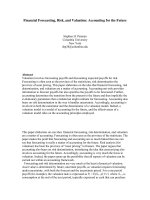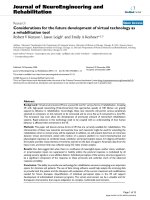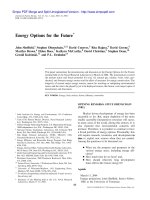INDUSTRIAL ROBOTS PROGRAMMING:BUILDING APPLICATIONS FOR THE FACTORIES OF THE FUTURE pot
Bạn đang xem bản rút gọn của tài liệu. Xem và tải ngay bản đầy đủ của tài liệu tại đây (19.3 MB, 289 trang )
INDUSTRIAL ROBOTS PROGRAMMING:
BUILDING APPLICATIONS FOR THE FACTORIES
OF THE FUTURE
INDUSTRIAL ROBOTS PROGRAMMING:
BUILDING APPLICATIONS FOR THE FACTORIES
OF THE FUTURE
J. Norberto Pires
Mechanical Engineering Department
University of Coimbra, Portugal
Spri
inger
/. Norberto Pires
Mechanical Engineering Department
University ofCoimbra
Portugal
Industrial Robots Programming: Building Applications for the Factories of the Future
Library of Congress Control Number: 2006932582
ISBN 0-387-23325-3 e-ISBN 0-387-23326-1
ISBN 9780387233253
Printed on acid-free paper.
© 2007 Springer Science+Business Media, LLC
All rights reserved. This work may not be translated or copied in whole or in part without
the written permission of the publisher (Springer Science+Business Media, LLC, 233 Spring
Street, New York, NY 10013, USA), except for brief excerpts in connection with reviews or
scholarly analysis. Use in connection with any form of information storage and retrieval,
electronic adaptation, computer software, or by similar or dissimilar methodology now
know or hereafter developed is forbidden.
The use in this publication of trade names, trademarks, service marks and similar terms,
even if they are not identified as such, is not to be taken as an expression of opinion as to
whether or not they are subject to proprietary rights.
987654321
springer.com
Dedicated to the memory of my father Joaquim
and to Dina, Rita, Beatriz and Olimpia.
Foreword
Robots have traditionally been used to work in industrial environments, as they
constitute the most flexible existing automation technology. In the recent years,
manufacturing systems are becoming more autonomous requiring less operator
intervention and a higher degree of customization and reconfigurability for
disparate applications. In this scenario, robot programming is a key factor toward
building the applications for the factories of the future.
This book by J. Norberto Pires constitutes a unique and authoritative reference in
our professional field, as one of
the
very few books written by an academic with a
strong industrial cut. The focus is on the software interfaces enabling humans and
machines to effectively cooperate on the shopfloor. Several sensors and controllers
are analyzed in detail, leading to the realization of interface devices using e.g.
speech recognition and CAD models, and their versatility for a number of
industrial manufacturing systems is enlightened.
Easy to read, rich in worked out examples and case studies, the book is
complemented with additional experimental material available on a web site,
including code and multimedia files, which the author promises to update
regularly.
It is my conviction the book will be appreciated by a wide readership, ranging from
technical engineers wishing to learn the foundations of industrial robotics to
scholars and researchers wishing to understand the needs and the potential of
a
new
generation of advanced industrial robots to be developed in the next decade.
Bruno Siciliano
Professor of Control and Robotics at the University of Naples
President-Elect of the IEEE Robotics and Automation Society
Preface
A scientific and technical book is a starting point. A source of information for
people browsing for details, a guide for others trying to build similar or related
solutions, or a source of inspiration for yet others wondering about how things
work.
This book was written by an engineer and university professor which has been
active in the field of industrial robotics since 1994. It was planned, designed and
built to serve engineers looking for better and more efficient systems, but also to
serve academic readers interested in the robotics area. The book focus mainly on
industrial robot programming in the beginning of the twentieth first century,
namely on the important issues related with designing, building and operating
flexible and agile robotic systems. It explores in detail the issue of software
interfaces, but also input/output devices and several industrial and laboratory
examples. In fact, the book uses several types of fully worked out examples to
illustrate and clarify concepts and ideas, enabling the reader to see them working
and even to test some of
them.
Most of
the
experimental material used in this book
can be obtained from:
hup://robotics,
dem.
uc.pt/indrobprog
This site will be updated regularly by the author constituting a source of
information, code and multimedia files which complement the contents of the
book.
Finally, the author wants to thank deeply to all the persons that contributed to this
book, namely all his undergraduate and graduate students, specially his Ph.D.
students Tiago Godinho and Gennano Veiga, and his M.Sc. student Ricardo
Araujo for their help and support in building and testing some of the solutions
presented in the book.
J. Norberto Pires, Coimbra, Portugal, 2006
Contents
1.
Introduction to the Industrial Robotics World 1
1.1 Introduction 1
1.2 A Brief History of the Industrial Robot 2
1.3 Using Robotics to Learn 9
1.3.1 Constitution of the Robot Nicola 12
1.3.2 Nicola Software 13
1.3.2.1
PLC Software 13
1.3.2.2
Software for the On-board PC 18
1.3.2.3
Feedback from the On-board Webcam 20
1.4 Using Robotics to Work 23
1.4.1 Using an Offline Simulation Environment 27
1.5 Statistics of Robotic Workers 29
1.6 Overview ofthe rest of the book 32
1.7 References 33
2.
Robot Manipulators and Control Systems 35
2.1 Introduction 35
2.2 Kinematics 36
2.2.1 Direct Kinematics 39
2.2.2 Inverse Kinematics 43
2.3 Jacobian 47
2.4 Singularities 58
2.4.1 Brief Overview: Singularity Approach 61
2.5 Position Sensing 66
2.6 Actuators: Motors 69
2.6.1 Motor Drive System 72
2.7 Dynamics 75
2.7.1 Inertia Tensor and Mass Distribution 76
2.7.1.1 Important Results 77
2.7.2 Lagrange-Euler Formulation 78
xii Industrial Robots Programming
2.7.3 D'Alembert Formulation 79
2.7.4 Newton-Euler Formulation 79
2.7.5 Dynamic Parameters 82
2.8 Matlab Examples 84
2.9 Robot Control Systems 86
2.9.1 Drive the motors to move the TCP and coordinate the motion for
useful work 87
2.10 Servo Control 90
2.11 10 Control 91
2.12 Communication 92
2.13 Sensor Interface 94
2.13.1 Interfacing Laser 3D Sensor for Seam Tracking 94
2.13.2 Interfacing a Force/Torque Sensor 96
2.13.2.1 Using a Force/Torque Sensor 100
2.14 Programming and Program Execution 103
2.15 User Interface 104
2.16 References 105
3.
Software Interfaces 109
3.1 Introduction 109
3.2 Low Level Interfaces 111
3.2.1 10 Digital Signals Ill
3.2.1.1
Robot Controller Software 116
3.2.1.2
PLC Software 118
3.2.1.3
PC Software 120
3.2.2 Using Fieldbuses 122
3.2.2.1
Profibus (Process FieldBus) 122
3.2.2.2
CAN (Controller Area Network) 122
3.2.2.3
DeviceNet 123
3.3 Data Protocols and Connections 125
3.3.1 RPC - Remote Procedure Calls 131
3.3.2 TCP/IP Sockets 135
3.3.2.1
TCP Ports 138
3.3.3 UDP Datagrams 138
3.3.3.1
UDP Ports 139
3.4 Simple Example: Interfacing a CCD Camera 139
3.4.1 Robot Controller Software 141
3.4.2 Webcam Software 143
3.4.3 Remote Client 147
3.4.4 Using UDP Datagrams 153
3.5 Simple Example: Control Panel 156
3.6 Simple Example: S4Misc - Data Access on a Remote Controller 158
3.7 Industrial Example: Semi-autonomous Labeling System 162
3.7.1 Robotic Labeling System 163
3.7.2 System Software 164
3.7.3 Robot Controller Software 166
3.7.4 TCP/IP Server 167
Contents xiii
3.7.5 Discussion 169
3.7.6 Conclusion 170
3.8 References 171
4.
Interface Devices and Systems 173
4.1 Introduction 173
4.2 Speech Interfaces 178
4.2.1 Introduction 178
4.2.2 Evolution 180
4.2.3 Technology 183
4.2.4 Automatic Speech Recognition System and Strategy 184
4.2.5 Pick-and-Place and Robotic Welding Examples 186
4.2.6 Pick-and-Place Example 187
4.2.7 Robotic Welding Example 191
4.2.8 Adjusting Process Variables 195
4.2.9 Conclusion 197
4.3 VoiceRobCam: Speech Interface for Robotics 198
4.3.1 Robot Manipulator and Robot Controller 199
4.3.2 PLC Siemens S7-200 and Server 200
4.3.3 Webcam and Image Processing Software 203
4.3.4 User Client Application 205
4.3.5 Speech Interface 210
4.4 CAD Interfaces 215
4.4.1 Speech Interface for Welding 221
4.5 References 223
5. Industrial Manufacturing Systems 225
5.1 Introduction 225
5.2 Helping Wrapping Machines for the Paper Industry 226
5.2.1 Layout of the System 227
5.2.1.1
Station One - Dimensions and Weight 228
5.2.1.2
Station Two - Roll Wrapping and Inner Header 228
5.2.1.3
Station Three-External Header 229
5.2.1.4
Station Four-Labeling 230
5.2.2 EmailWare 233
5.2.2.1
EmailWare Application Example 237
5.2.3 Conclusions and Discussion 241
5.3 Complete Robotic Inspection Line for the Ceramic Industry 241
5.3.1 Motivation and Goals 242
5.3.2 Approach and Results 246
5.3.2.1
Basic Functioning of the De-palletizing System 248
5.3.2.2
Basic Functioning of the Palletizing System 248
5.3.3 Operational Results and Discussion 250
5.4 Handling Production Changes Online 251
5.4.1 Robotic Palletizing System 252
5.4.1.1
Identify Empty Pallets and Measure Parameters of an Empty Pallet
253
xiv Industrial Robots Programming
5.4.1.2
Pick a Glass from the Production Line 254
5.4.1.3
Palletize the Glass 254
5.4.2 System Software 256
5.4.3 On-line monitoring 260
5.4.4 Discussion and Results 263
5.4.5 Conclusion 265
5.5 References 265
6. Final Notes 267
6.1 Introduction 267
6.2 Operation "^/Z7^rr 268
6.2.1 And ''Albert Speaks 275
6.3 References 280
Index 281
Introduction to the Industrial Robotics World
1.1 Introduction
Robotics is a subject that leaves nobody indifferent. No matter if they are used to
work in industry or at our homes, mimic some of
the
human capabilities, or used to
access dangerous environments, launched to space, or simply used to play with,
robots are always a source of interest and admiration. Here the focus is in robots
used to work on industrial environments [1], i.e., robots built to substitute man on
certain industrial manufacturing tasks being a mechatronic coworker for humans.
In fact, actual manufacturing setups rely increasingly on technology. It is common
to have all sources of equipment on the shop floor commanded by industrial
computers or PLCs connected by an industrial network to other factory resources.
Also,
manufacturing systems are becoming more autonomous, requiring less
operator intervention in daily operations. This is a consequence of today's market
conditions, characterized by global competition, a strong pressure for better quality
at lower
prices,
and products defined in part by the end-user. This means producing
in small batches, never risking long stocks, and working to satisfy existing
customer orders. Consequently, concepts like flexibility and agility are
fundamental in actual manufacturing plants, requiring much more from the systems
used on the shop floor. Flexible manufacturing systems take advantage of being
composed by programmable equipment to implement most of its characteristics,
which are supported by reconfigurable mechanical parts.
Industrial robots are good examples of flexible manufacturing systems. Using
robots in actual manufacturing platforms is, therefore, a decision to improve
flexibility and to increase the agility of the manufacturing process. If the
manufacturing processes are complex, with a low cycle time, and have a lot of
parameterization due to the diversity of products, then using robots is the correct
decision, although it isn't enough for a complete solution. In fact, engineers need to
Industrial Robots Programming
integrate other technologies with the objective of extracting from robots the
flexibility they can offer. That means using computers for controlling and
supervising manufacturing systems, industrial networks, and distributed software
architectures
[2,3].
It also means designing application software that is really
distributed on the shop floor, taking advantage of the flexibility installed by using
programmable equipment. Finally, it means taking special care of the human-
machine interfaces (HMI), i.e., the devices, interfaces, and systems that enable
humans and machines to cooperate on the shop floor as coworkers, taking
advantage of each other's capabilities.
1.2 A Brief History of
the
Industrial Robot
The word ''robof comes from the Czech ''robota'' which means tireless work It
was first used in 1921 by the novelist Karel Capek in his novel ''Rossum's
Universal Robots". Capek's robots (Figure 1.1) are tireless working machines that
looked like humans and had advanced capabilities even when compared with
actual robots. The fantasy associated with robotics offered by science fiction
movies, and printed and animated cartoons is so far from reality that actual
industrial robots seem primitive compared with the likes of C3P0 and R2-D2
(from the movie Star Wars), Cyber dyne
TIOOO
(from the movie Terminator 11)
Bishop (from the movie Alien II) and Sonny (from the moviQ I Robot), for example.
Figure 1.1 A robot from Karel
Capek's
novel
''Rossum 's Universal
Robots''
Introduction to the Industrial Robotics World
But robotics was a special concern of the most brilliant minds of our common
history, since many of them took time to imagine, design, and build machines that
could mimic some human capabilities. It is one of the biggest dreams of man, to
build obedient and tireless machines, capable of doing man's boring and repetitive
work; an idea very well explained by Nicola Tesla in his diary [4]:
'' / conceived the idea of constructing an automaton which would
mechanically represent me, and which would respond, as I do
myself,
but,
of course, in a much more primitive manner, to external influences. Such an
automaton evidently had to have motive power, organs for locomotion,
directive organs, and one or more sensitive organs so adapted as to be
excited by external stimuli ".
Figure 1.2 Water clocks designed by
Ctecibius
{11
()
B.C.)
Today's challenge is to consider robots as human coworkers and companions,
extending human capabilities to achieve more efficient manufacturing and to
increase the quality of our lives. This book focuses on industrial robotic coworkers.
The fields of robotics that consider the companion aspects, namely service robotics
and humanoid robotics, are not covered in this book. Nevertheless, the social
perspective of using robots not only as coworkers, but also as personal assistants, is
very promising. In fact, due to several social and economical factors, we are
required to work until very late in life: It is common in Europe to only allow
Industrial Robots Programming
retirement when a person is near seventy years old. Since our physical and mental
capabilities decrease with time, the possibility of having mechanical assistants that
could help us in our normal routine has some valuable interest.
Robotics can be traced back to 350 B.C., in the ancient Greece, to the fabulous
philosopher and mathematician Archytas of Tarentum (428-347 B.C.) and a
demonstration he made in front of the metropolis senators. A strange machine that
he called "the pigeon'' was capable of flying more the 200m, using some type of jet
propulsion based on steam and compressed air: a great achievement for the time
(the invention of the screw and also the pulley are attributed to Archytas).
-e^a
im^^
Figure 1.3 A Greek design adapted by
al-Jazari
for a garden hand-washer
In 270 B.C., also in ancient Greece, the civil engineer Ctecibius was capable of
building water clocks with moving parts (Figure 1.2). His work had followers like
Phylo of Byzantium author of the book ''Mechanical Collection'' (200 B.C.), and
Introduction to the Industrial Robotics World
Hero of Alexandria (85 B.C.), and Marcus Vitruvius (25 B.C.). In the twelfth
century, the Arabian Badias-zaman al-Jazari (1150-1220) recollected some of the
Greek developments in the book ''The Science of the Ingenious Devices'' [5]
(Figure 1.3), and that is how they reached our time. In those early times the
problem was about mechanics, about how to generate and transmit motion. So it
was mainly about mechanisms, ingenious mechanical devices
[5,6].
Then in the fifteenth century, Leonardo da Vinci showed indirectly that the
problems were the lack of precision and the lack of a permanent power source. He
designed mechanisms to generate and transmit motion, and even some ways to
store small amounts of mechanical energy [7]. But he didn't have the means to
build those mechanisms with enough precision and there was no permanent power
source available (pneumatic, hydraulic, or electric). Maybe that was why he didn't
finish his robot project
[5,6],
a fifteenth century knight robot (Figure 1.4) intended
to be placed in the ''Salle delle Asse'' of the Sforza family castle in Milan, Italy. It
wasn't good enough. Or it was so revolutionary an idea for the time that he thought
that maybe it was better to make it disappear
[5,6].
Figure 1.4 Leonardo's studies for a humanoid robot
And then there was the contribution of Nicola Tesla at the turn of the nineteenth
century. He thought of using Henrich Hertz's discovery of radio waves (following
the work of James Clerk Maxwell about electromagnetic phenomena) to command
Industrial Robots Programming
an automata. He built one (Figure 1.5) to demonstrate his ideas and presented it in
New York's Madison Square Garden in 1898
[4,6].
The problem then was that
machine intelligence was missing. Robots should be able to do pre-programmed
operations, and show some degree of autonomy in order to perform the desired
tasks.
When that became available, robots developed rapidly, and the first
industrial one appeared in the early 1970s and spawned a multi-million dollar
business.
After that, robotic evolution was not as fantastic as it could have been, since there
was a lot to do and the available machines were sufficiently powerful to handle the
requested jobs. Manufacturers were more or less happy with their robots, and
consequently industrial robots remained position-controlled, somehow difficult to
program by regular operators, and really not especially exciting machines. Features
currently common in research laboratories hadn't reached industry yet because of a
lack of interest from robot manufacturers. Nevertheless, there was a considerable
evolution that can be summarized as follows.
Figure 1.5 Nicola Tesla's remote-controlled miniature submarine
In 1974, the first electrical drive trains were available to use as actuators for robot
joints.
In the same year, the first microprocessor-controlled robots were also
available commercially.
Around 1982, things like Cartesian interpolation for path planning were available
in robot controllers, and many of them were also capable of communicating with
other computer systems using serial and parallel interfaces. In the same year, some
Introduction to the Industrial Robotics World
manufacturers introduced joystick control for easier programming, and the teach
pendant menu interface.
In 1984, vision guidance was introduced as a general feature for tracking, parts
identification, and so on.
In 1986, the first digital control loops were implemented enabling better actuator
control and enabling the use of AC drives.
Networking is a feature of the 1990s, with several manufacturers implementing
networking capabilities and protocols.
In 1991, there was the implementation of digital torque control loops, which
enabled, for example, the utilization of full dynamical models; a feature only
available in the first robots around 1994.
During the period 1992-1994 several manufacturers introduced features like
Windows-based graphical interfaces, virtual robot environments for off-line
programming, andfieldbuses.
Robot cooperation is a feature introduced from 1995 to 1996.
^Ti'-
•_,^
Figure 1.6 Actual robot manipulators
Around 1998, robot manufacturers started introducing collision detection to avoid
damaging robots, and load identification to optimize robot performance. Since then
other features include fast pick and place, weight reduction, optimized
programming languages, object-oriented programming, remote interfaces using
RPC sockets and TCP/IP sockets, etc Figure 1.6 shows some of the robot
manipulators available currently on the market.
So how do we define robotics then? Is it a science? Is it a technique or collection of
techniques? If the reader opens a robotics book something like this appears:
8 Industrial Robots Programming
''A robot is a re-programmable multi-functional manipulator designed to
move materials, parts, tools, or specialized devices, through variable
programmed motions for the performance of a variety of tasks
",
from the
book Robotics - Control, Sensing, Vision and Intelligence, Fu, Gonzalez,
Lee, MacGrawHill, 1987.
Although correct, despite being restricted to robot manipulators, this definition
doesn't give the correct idea. The common sense image of a robot is usually
associated with strong and superb machines, tireless (like Karel Capek's
machines), obedient
i^'yes,
noberto san
"),
but nevertheless, fascinating machines
that make us dream. And that fascination is not in that definition.
As with everything, we should look to the past and pick what was fundamental for
the history of robotics in terms of ideas and dreams. From the Greeks and Arabs
we should pick their idea of ''ingenious devices''. In fact, robotics is very much
about mechanics, motion, mechanisms to transmit motion, and having the art and
the skill to design and build those mechanisms. Yes, "ingenious devices" is really a
good start.
Then we should turn to Leonardo (sixteenth century) and look to his quest for "
precision " and '' permanentpower source ". He understood that robots need
parts built with very high precision and a permanent power source. That was not
available at his time, i.e., machine tools and a permanent power source (electric,
hydraulic, or pneumatic).
Finally, we should read Nicola Tesla and observe his outstanding and visionary
work. He understood that robots are a consequence of dreams and neat ideas.
Robots need to be controlled and programmed, distinguish situations, etc., have
ways of "understanding'', and that means using computers, electronics, software,
and sensors, in a way to enable machines to be programmed and to sense their
environment. Those are the elements that enable us scientists, engineers, and robot
users to try different things and new ideas, being a source of fascination. In his
own words [4]:
** But this element I could easily embody in it by conveying to it my own
intelligence, my own understanding. So this invention was evolved, and so a
new art came into existence, for which the name ''teleautomatics " has been
suggested, which means the art of controlling movements and operations of
distant automatons.
Therefore, we can define robotics as a science of generic, ingenious, precise,
mechatronic devices, powered by a permanent power source; a science that is open
to new ideas and that stimulates the imagination. A stimulus so strong that it
attracted many of the best minds of our common history, i.e., authors of the work
that constitutes the legacy that we humans leave for the future.
Introduction
to
the Industrial Robotics World
1.3 Using Robotics to Learn
Putting robots in space, and in other planets, is a very exciting field of modem
robotics. This and other fantastic achievements justify the enormous interest about
robots and robotic applications. Only a few engineering fields are as
multidisciplinary as robotics, i.e., areas that require knowledge of as many
different scientific and technical disciplines. Robotics integrates an extensive
knowledge of physics, mechanics, electronics, computer science, data
communications, and many other scientific and technical areas important for the
design, construction, and operation of machines that execute human-like functions.
Figure 1.7 Robot
MER-A {Spirit)
sent
to
Mars in June of 2003 (from
NASA)
[8]
In this section a small mobile robot, named Nicola, is presented. The robot is
constructed, using commonly available industrial equipment, to be commanded
from a typical personal computer running standard operating systems and software
development tools. The final goal is to demonstrate what is involved in the
construction of this type of robot, showing that it is possible to play with science
and technology and in the process learn and spend a fantastic time. The robot
Nicola will be presented step-by-step with enough detail for showing what is
involved.
NASA initiated in June 2003 a new mission to further explore Mars, the great red
planet of our solar system [8]. The allure of Mars is based on its proximity to
Earth, but also on the assumption that it was once like Earth, with water available
10 Industrial Robots Programming
on the surface and life, before changing gradually to
a
hot and dusty planet.
In
this
mission, NASA used again semi-autonomous mobile robots
to
explore the planet.
These Mars exploration rovers (MER
-
Figure 1.7), named Spirit and Opportunity,
are capable
of
navigating
the
surface
of
the planet, analyzing rocks
and
land,
and
sending back pictures, videos,
and
results from experiments carried
out on the
planet's surface. The spaceship that carried Spirit was launched
on
June 10,
2003,
and arrived
on
Mars
on
January
4,
2004.
In
turn,
the
spaceship that carried
Opportunity left on July 7,
2003,
and arrived on Mars on January 25, 2004.
The utilization
of
these robots
was
also
a
dream
of
the great Croatian inventor
Nicola Tesla (1845-1943),
a
man that gave
a
pioneering and visionary contribution
for
the
evolution
of
robotics.
He
worked with
the
legendary Thomas Edison
and
was
a
tireless, dedicated,
and
bright inventor. Tesla
was the
archetype
of the
inventor: solitary, absent minded, abstracted
of
the normal things
of
life, with
an
exclusive dedication
to his
work
and
visionary.
At the end of the
nineteenth
century he dreamt (doesn't everything begins like this?!) oiautomatons capable
of
performing tasks only possible
to
intelligent living creatures.
For
that,
the
automaton needed
an
element equivalent
to the
human brain. Since that seemed
complicated,
he
thought about using his own brain
for
commanding the automaton
[4].
SWITCH
BATT-
CAPACirOR
PtATES-H
1^
RftUPTER
PRI<
>SEC
INDUC'
J"
HON
OCML
SPAflKfiALLS
Figure 1.8 Heinrich Hertz's first transmitter, 1886 schematic
That capacity
of
commanding distant automatons
was
achieved using Henrich
Hertz waves (published
in
1887
in a
treatise named ''Optice Elettrica''), Tesla had
access
to
Hertz's publications
and saw in his
radio transmitters
and
receivers
(Figure 1.8)
a
way to implement his own ideas. To demonstrate the principle, Tesla
built
a
model
of a
submarine (Figure
1.5)
controlled remotely using coded hertz
impulses (controlled by radio, therefore). He could command the boat to turn to the
right
or
to the left, submerge and emerge, etc. Despite the enormous interest
of
the
new invention, which he demonstrated in the Madison Square Garden of New York
City (1898), before
an
overwhelmed audience,
he
failed
to
obtain support
to
continue his efforts on the subject.
Introduction to the Industrial Robotics World 11
HUB USB
2 Batteries
(+12V)
WebCam Wireless ethernet card
Laptop
Industrial PLC
Siemens S7200
Power Unit: DC Motor (24V, 50W), planetaiy gearhead
25:1,
velocity control circuitry
a)
Solar panels
b)
Figure 1.9 The Robot
Nicola:
a) Nicola I; b) Nicola II
But it was a fabulous advancement for the time (nineteenth century). How would it
be building a system with those characteristics today? Using common industrial
equipment, wireless communications, actual operating systems, and well known
programming tools?
That is the goal of our robot Nicola, i.e., to show that Tesla's dream is still actual,
and that despite the sophistication of those robotic space explorers (Figure 1.8), the
technology involved and the concepts are simple, accessible, and fun to learn how
it all basically works.
12 Industrial Robots Programming
1.3.1 Constitution of the Robot Nicola
The robot Nicola is very simple. Basically it is a three-wheel robot with two power
wheels in front and a free wheel in the back (Figure 1.9). The wheels used are of
the same type that can be found in office chairs and other office equipment. Each
of the two power wheels are equipped with a power unit composed of
1.
One 24 V DC motor (max. power 50 W, max. velocity 3650 rpm, max.
torque 0.17 Nm), model MDLC-58 from Maclennan Ltd. [9]
2.
One 25:1 gear unit, model IP57-M2 from Maclennan Ltd. [9]
The selected DC motor is equipped with a velocity control loop (Figure
1.10),
which makes it very simple to linearly control velocity just by feeding the unit with
a 0-5 V analog signal. The control circuit is a very simple electronic circuit
composed of a velocity control loop and a power amplifier. The velocity control
loop makes the motor velocity proportional to the commanding analog signal (0-5
V in magnitude), and the rotating velocity is defined by a digital input (0 - positive
direction, 1 - negative direction).
V elULil^ ^^^^^"^
V elo c ity ^
Reference
Direction ^^^^^"
Digital
Control Loop
i t
Analog
Velocity
Control Loop
Power
Amplifier
DC Motor
(BLDC 58)
^^r
- ••
• • ^j^B
Figure 1.10 Diagram of the velocity control circuitry [9]
Using this power unit, attached to each wheel, there is no need for a mechanical
steering mechanism since the electric differential effect can be used to steer the
robot, i.e., varying the speed of each independently wheel it is possible to turn to
the right and to the left with high-precision and several curvature radius. For
example, if the speed of the left wheel (vi) is equal to the speed of the right wheel
(Vr),
the robot moves forward in a straight line (vi =
Vr
> 0). If we change the sense
of rotation of the wheels (vi =
Vr
< 0), the robot moves backwards also in a straight
line.
Making
Vi
> Vr, the robot turns to the right, and with vi <
Vr
it turns to the left.
Adjusting the value of
vi
and Vr several curvature radius may be obtained. Finally,
making vi
==
-Vi-
the robot turns about itself
Introduction to the Industrial Robotics World 13
Furthermore, with the objective of using industrial components, the robot uses a
medium class PLC {Programmable Logic Controller) to interface with sensors and
actuators. The selected PLC is a Siemens S7-200 (DC model with the 215 CPU),
equipped with a 12-bit resolution analog module (module EM235, with three
inputs and one output) [10].
To command the robot, a laptop is installed on the robot, connected to the PLC
using a serial link (RS-232C channel). The software running on the laptop was
built to work as a TCP/IP socket server, enabling commands by any authorized
remote client. The operating system running on the PC is the Microsoft Windows
XP, which makes it easy to add advanced services, attach devices (like network
devices, Webcams, etc.), and explore them from available software developing
tools {Visual Basic, C++, C#, etc.).
1.3.2 Nicola Software
The software designed to control and operate Nicola is divided into three levels,
identified with the programmable hardware components that constitute the robot:
1.
The PLC that implements the low-level interface with sensors and
actuators
2.
The on-board PC used to manage the robot and interface with remote
users
3.
The commanding PC, i.e., the computer used to command the robot and
monitor its operation
In the following sections the software will be presented in detail. The interested
reader can download the source code from [11].
1,3,2.1
PLC Software
The mission of the PLC is to interface with analog and digital sensors that could be
used with the robot, and to control the two DC motors that move the robot and any
other actuator that could be added to the system. Consequently, a PLC is a good
choice since this is basically what is required from them in industry, i.e., to work as
local and low-level interfaces with sensors and actuators implementing sequential
commanding routines. In addition, PLCs are very easy to use and to program,
which also justifies the solution. The only difficulty with the PLC is the need to
have it working as a server, executing the commands sent by the on-board PC that
manages the robot (Figure
1.11).
This means that the PLC should implement the
services required to operate the robot, namely:
1.
The possibility to change any analog or digital output
2.
The possibility to access any analog or digital input
3.
The possibility to command macros, or batches of functions
14 Industrial Robots Programming
4.
The possibility
to
receive events with detailed information about the status
of the robot.
Command Message
Answer
Sup ervision M e ss age
Figure 1.11 Messages between the on-board PC and the PLC
Table 1.1 List of PLC command codes
Command
159
160
200
201
253
Parameter 1
120 +output
120 + input
120 +output
130 +output
120 +output
130 +output
-
Parameter 2
Valor
-
-
Description
Changes the specified analog
output.
Reads the actual value of the
specified analog input.
Activates the specified digital
output of the first output block
(120) or of the second output
block (130).
Deactivates the specified digital
output of the first output block
(120) or of the second output
block (130).
Supervision message.
This idea
is
very simple
and not
different from what
is
done
in
more advanced
machines, like
the
industrial robots. From
the
remote client, properly authorized,
the user accesses memory zones
to
change some predefined variables (bytes, word
or double-word variables).
If the
value
of
those variables
is
used
in the
programmed instructions,
it is
possible
to
execute only
the
intended sequences just
by comprehensively changing
the
values
of
those variables.
The PLC
answers
to
remote commands sent with
a
pre-defined format
and
with
a
maximum length
of
Introduction to the Industrial Robotics World 15
100 bytes. The first byte of the commanding message specifies the command, and
the following bytes are parameters (see Table 1.1).
The synchronous answer of any command is a copy of the message received,
which enables the commanding PC to check if the command was well received
using for example an ACK-NACK (acknowledge - not acknowledge) protocol.
Besides that, there is a special command (code = 253) used for monitoring the PLC
state.
When the PLC receives this command it should answer by sending the state
of
all
its 10 inputs and outputs. This message should be sent frequently to track the
robot state. In the robot Nicola this message is associated to a 500 ms timer, which
means that the robot state is updated at a frequency of 2 Hz.
Any asynchronous answer contains the execution results of one command. For
easy identification from the serial port interrupt routine, the first byte of the answer
identifies the code of the executed command. The user commands should be
associated with user actions like pressing software buttons or keyboard buttons,
etc.
When the PLC receives a command, it transfers the received data into a pre-
defined memory zone starting with register VB90. Consequently, if the command
contains n bytes, with n <= 100, the following happens:
Byte VB90 ~ contains the number of byte received
Byte
VB91
- contains the character (code) that identifies the command
Byte VB92 - contains parameter 1
Byte VB90 + n -1 - contains parameter n
The PLC routine designed to handle the serial port initializes the port in the first
SCAN cycle, entering after that into the listen state. When a message is received,
the data is transferred to the already mentioned memory zone and a copy is sent
back to the calling PC.
For example, the PLC used with
Nicola {Siemens 87-200)
has 10 digital outputs in
the basic module, labeled from QO.O to Q0.7 (output block 0), and from Ql.O to
QLl (output block 1). To access those digital outputs, the command must specify
the type of access (write or a read access), the signal number, and the signal value
in the case of a write access (check Table LI).









